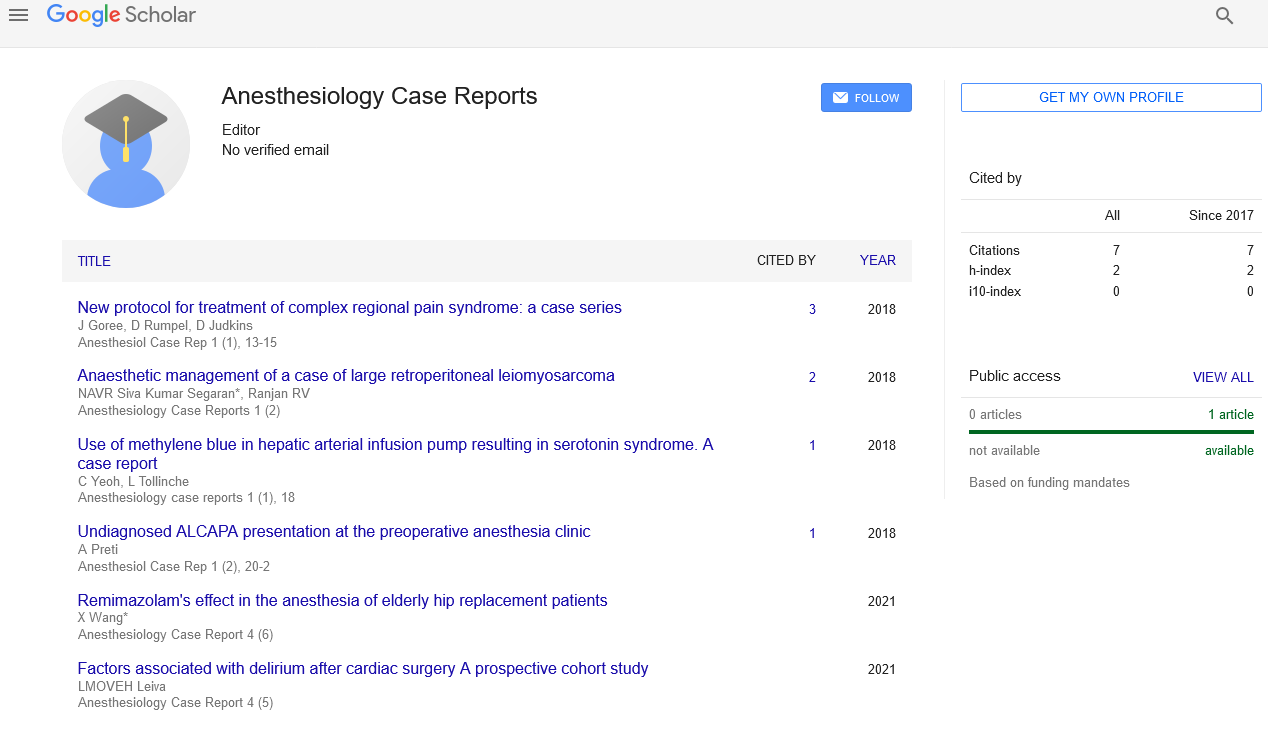Short note on Trigeminal neuralgia
Received: 03-Mar-2022, Manuscript No. pulacr-22-5593; Editor assigned: 05-Mar-2022, Pre QC No. pulacr-22-5593 (PQ); Accepted Date: Mar 28, 2022; Reviewed: 19-Mar-2022 QC No. pulacr-22-5593 (Q); Revised: 26-Mar-2022, Manuscript No. pulacr-22-5593 (R); Published: 02-Apr-2022, DOI: 10.37532. pulacr-22.5.3.1-2
Citation: Paharasi D, Kainthola A. Short note on trigeminal neuralgia. Anesthesiol Case Rep. 2022; 5(3):1-2.
This open-access article is distributed under the terms of the Creative Commons Attribution Non-Commercial License (CC BY-NC) (http://creativecommons.org/licenses/by-nc/4.0/), which permits reuse, distribution and reproduction of the article, provided that the original work is properly cited and the reuse is restricted to noncommercial purposes. For commercial reuse, contact reprints@pulsus.com
Abstract
The neurological condition Trigeminal Neuralgia (TGN), also known as "Tic Douloureux" affects the sensory portion of the fifth cranial (trigeminal) nerve and is characterized by recurrent episodes of intense, shock-like pain that are localized to one or more of the nerve's three major branches: The Ophthalmic (V1), Maxillary (V2), or Mandibular (V3). Typically, when certain trigger zones are stimulated by movement or contact, painful, lancinating facial pain results. The lips, gums, cheek, or chin may all be affected by paroxysmal pain. TGN is uncommon before the third decade of life and affects roughly 1 person in 25,000 people in the general population.
Keywords
Local anesthetic; Eye anesthetic; Trigeminal neuralgia; Antidepressants; Pharmacotherapy
Introduction
Currently, the first-line treatment for Trigeminal Neuralgia TGN is pharmacotherapy, which includes analgesics, anticonvulsants, and antidepressants. Surgery is only used to address persistent, intractable pain. A strong surface local anesthetic, methocaine is a 2- (dimethylamino) ethyl ester of 4-(butylamino) benzoic acid, which blocks sensory nerve endings close to the application site. Amethocaine hydrochloride is a medication used in ophthalmology to numb the cornea during ophthalmological operations. Previous studies discovered that a single application of an eye drops of amethocaine did not provide any statistically meaningful pain alleviation [1-3].
Trigeminal Neuralgia
John Fothergill is credited with describing Trigeminal Neuralgia TGN for the first time in 1773 (also known as Fothergill's sickness). Avicenna's texts from the 11th century do, however, contain early accounts [1].
The fifth cranial nerve's distribution, which includes one or more of its branches, is where the International Association of Pain describes TGN as a recurrent, typically unilateral, short-stabbing pain [2,3]. A local anesthetic called methocaine hydrochlorides is particularly helpful for reducing discomfort after removing foreign objects from the eye and is used for minor conjunctival and corneal surgery. TGN may be benign Gasserian ganglion compression or due to multiple sclerosis or idiopathic (classic) (the sensory ganglion of the trigeminal nerve) [4].
The trigeminal nerve supplies the face, teeth, mouth, and nasal cavity through its sensory root, which spreads into the trigeminal ganglion, which houses the cells that give rise to the sensory fibers and from which the three divisions of the nerve emerge. By chance, Zavon and Fichte 1991 learned that TGN might be treated using eye anesthetics (proparacaine). TGN patient Zavon discovered that his pain stopped for more than a year as soon as an eye anesthetic was used (to treat corneal ulcers). When they used the anesthetic on a second TGN patient, they were able to relieve their discomfort for more than a month [5].
Using eye anesthetics frequently has been linked to toxic keratopathy and slowed wound healing in the eyes. As a result, it was urged that eye anesthetics be used with extreme caution and that patients not wipe their eyes for at least an hour after the procedure. TGN treatment goals include eliminating pain, lowering the risk of recurrence, and lengthening the time before recurrence through the selective destruction of pain fibers without causing significant sensory loss, motor dysfunction, or other side effects. TGN may be treated surgically, using microvascular decompression, partial trigeminal rhizotomy, stereotactic radiosurgery, radiofrequency denervation, cryotherapy, or chemical denervation targeted at the trigeminal nerve's root (rhizotomy), ganglion (gangliolysis), or branches [6],[7]. These, however, need additional skill, intrusive treatments, and a high risk of complications.
Prior research has demonstrated the safety and efficacy of peripheral nerve blocks using high concentrations of local anesthetics for the treatment of TGN, providing pain relief for weeks following an infraorbital block [8],[9]. Poor-quality methodological trials hinder the treatment of TGN as a whole.
References
- Cole CD, Liu JK, Apfelbaum RI. Historical perspectives on the diagnosis and treatment of trigeminal neuralgia. Neurosurg Focus. 2005;18(5):1-0. [Google Scholar] [Crossref]
- Kitt CA, Gruber K, Davis M, et al. Trigeminal neuralgia: opportunities for research and treatment. Pain. 2000;85:3â??7. [Google Scholar] [Crossref]
- Kondziolka D, Lemley T, Kestle JR, et al. The effect of single-application topical ophthalmic anesthesia in patients with trigeminal neuralgia. A randomized double-blind placebo-controlled trial. J Neurosurg. 1994;80:993â??997. [Google Scholar] [Crossref]
- Nurmikko TJ, Eldridge PR. Trigeminal neuralgia: pathophysiology, diagnosis and current treatment. Br J Anaesth. 2001;87:117â??132. [Google Scholar] [Crossref]
- Zavon MR, Fichte CM. Trigeminal neuralgia relieved by ophthalmic anesthetic. JAMA. 1991;265:2807. [Google Scholar] [Crossref]
- Lopez BC, Hamlyn PJ, Zakrzewska JM. Systematic review of ablative neurosurgical techniques for the treatment of trigeminal neuralgia. Neurosurgery. 2004;54:973â??982. [Google Scholar]
- Mathews ES, Scrivani SJ. Percutaneous stereotactic radiofrequency thermal rhizotomy for the treatment of trigeminal neuralgia. Mt Sinai J Med. 2000;67:288â??299. [Google Scholar]
- Radwan IA, Saito S, Goto F. High-concentration tetracaine for the management of trigeminal neuralgia: quantitative assessment of sensory function after peripheral nerve block. Clin J Pain. 2001;17:323â??326. [Google Scholar]
- Goto F, Ishizaki K, Yoshikawa D, et al. The long lasting effects of peripheral nerve blocks for trigeminal neuralgia using high concentration of tetracaine dissolved in bupivacaine. Pain. 1999;79:101â??103. [Google Scholar] [Crossref]





